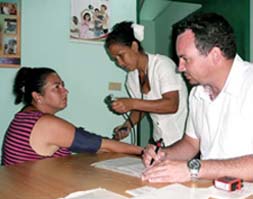Quality of medical care in chosen Doctor’s office
Keywords:
STRUCTURE, PROCESS ASSESSMENT/health care, QUALITY OF HEALTH CARE, PRIMARY HEALTH CARE.Abstract
Introduction: the varieties of quality control have been transformed over time by Vuori and Donabedian, who have made great contributions to the varieties of quality control, the latter, considered the founder of the study of the quality of care health, defined as: activities aimed at ensuring accessible and equitable services, with optimal professional benefits, bearing in mind the available resources, achieving adherence and user satisfaction with the care received.
Objective: to evaluate the quality of medical care at Pedro Borras University Polyclinic in Pinar del Río, in the last quarter of 2016.
Method: a descriptive, prospective and cross-sectional study was carried out, through the methodological proposal to evaluate the quality in the Primary Health Care, including Process and Results data. The target group consisted of one thousand 294 patients belonging to a randomly chosen clinic, a sample of convenience was taken including the 152 patients older than 15 years old assigned to perform the analysis of the health situation.
Results: the age group that predominated was 65 years and older, the main cause of consultation was upper respiratory infections, the medical care provided was considered of quality, the highest number of the predetermined standards exceeded the established percentage, both in medical performance and in user satisfaction.
Conclusions: it was found that the quality of the medical care provided in the chosen clinic was considered satisfactory by both researchers and users.
Downloads
References
1- Coronado R, Cruz E, Macías S, Arellano A, Macías C, Nava T .El contexto actual de la calidad en salud y sus indicadores. Revista Mex de Med Fís y Rehab. 2013 [Citado 2014 Marz 9]; 25(1):26-33. Disponible en: http://www.medigraphic.com/pdfs/fisica/mf-2013/mf131e.pdf
2- Márquez N. El ingreso en el hogar como proceso de la atención primaria de salud. Rev Cub Med Gen Integ. 2012 [Citado 2014 Mar 6]; 28(1):[aprox 1]. Disponible en:
http://scielo.sld.cu/scielo.php?script=sci_arttext&pid=S0864-21252012000100009
3- Fernández A, Galvan R. La Medicina Familiar en los albores de su treinta aniversario. Rev Medisur. 2014 [Citado 2014 Marz 6]; 12(1): [aprox1].Disponible en: http://medisur.sld.cu/index.php/medisur/article/view/2721/1387
4-MINSAP.Objetivos de trabajo del MINSAP .La Habana, Cuba; 2013.
5- Ramirez M, Rodriguez D, Landrove O, Pena M, Valdivia C, Cerrano C. Sistema de monitoreo y evaluación de la calidad de la atención médica en las enfermedades no transmisibles. Rev Cubana Hig Epid. 2001 [Citado 2014 Marz 2]; 39(3):[aprox 7]. Disponible en:
http://scielo.sld.cu/scielo.php?script=sci_arttext&pid=S1561-30032001000300001
6-Cardoso E, Cerecedo M. Propuesta de indicadores para evaluar la calidad de un programa de posgrado en Educación. RevElecInvEduc. 2011 [Citado 2014 Marz 10]; 13(2):[Aprox 6]. Disponible en:
http://www.scielo.org.mx/scielo.php?script=sci_arttext&pid=S1607-40412011000200005
7- Dair R, Torres E, Rodríguez O, Cruz R , Hernández L . Control de la calidad del seguimiento de contactos de tuberculosis pulmonar en Camagüey, Cuba. RevBiom 2014 [Citado 2014 Marz 10]; 14(1):[Aprox 8]. Disponible en:
http://www.mednet.cl/link.cgi/Medwave/Estudios/Investigacion/5895
8-- Duarte S, Toledano Y , Lafargue D, Del Campo L, Cuba M. Calidad de la ejecución del Programa Nacional de Control de la Tuberculosis en el Policlínico Universitario "José Martí", . RevMedisan 2013 [Citado 2014 Marz 10]; 17(5):[Aprox 6]. Disponible en:
http://scielo.sld.cu/scielo.php?pid=S1029-30192013000500011&script=sci_arttext
9-- Pérez N, Gómez M, Anglo E, García A. Propuesta de una metodología para la evaluación de la calidad de la atención al paciente pediátrico con cáncer en la Atención Primaria de Salud. RevMciego 2013 [Citado 2014 Marz 2]; 19(2): [aprox 8]. Disponible en:
http://www.bvs.sld.cu/revistas/mciego/vol19_supl2_2013/pdf/T10.pdf
10-Collazo M, Calero J, Rodríguez A. Necesidades, realidades y posibilidades del sistema de salud cubano para su enfrentamiento al envejecimiento poblacional.RevCub Sal Pub. 2010 [Citado 2014 Marz 2]; 36(2): [aprox 7]. Disponible en:http://scielo.sld.cu/scielo.php?pid=S0864-34662010000200009&script=sci_arttext
11- Antolinez M, Alonso L. ¿Está preparado nuestro país para asumir los retos
que plantea el envejecimiento poblacional?. Rev Salud Uninorte. 2007 [Citado 2014 Marz 2]; 23 (2): 292-301 .Disponible en:
http://rcientificas.uninorte.edu.co/index.php/salud/article/viewArticle/4043
12- Lineamientos de la Política Económica y Social del Partido y la Revolución en la Universidad de Ciencias Médicas de Pinar del Río. La Habana, Cuba; 2012.
13- Infante M, Pacheco C, Velazquez Y, Hernández T, Mendo N. Calidad de la ejecución del Programa de Lepra en el Policlínico Universitario "José Martí". RevMedisan. 2012 [Citado 2014 Marz 9]; 16(11):1666. Disponible en:
http://scielo.sld.cu/scielo.php?script=sci_arttext&pid=S1029-30192012001100003
14- MINSAP. Programa del médico y la enfermera de la familia. La Habana, Cuba; 2013.
15- García A, María J, Trilla A. ¿Por qué solicitan cambiar de médico los usuarios de un centro de atención primaria?RevGac San. 2013 [Citado 2014 Marz 9]; 27(1): [aprox 3]. Disponible en:
http://www.scielosp.org/scielo.php?pid=S0213-91112013000100021&script=sci_arttext

Published
How to Cite
Issue
Section
License
Authors who have publications with this journal agree to the following terms: Authors will retain their copyrights and grant the journal the right of first publication of their work, which will be publication of their work, which will be simultaneously subject to the Creative Commons Attribution License (CC-BY-NC 4.0) that allows third parties to share the work as long as its author and first publication in this journal are indicated.
Authors may adopt other non-exclusive license agreements for distribution of the published version of the work (e.g.: deposit it in an institutional telematic archive or publish it in a volume). Likewise, and according to the recommendations of the Medical Sciences Editorial (ECIMED), authors must declare in each article their contribution according to the CRediT taxonomy (contributor roles). This taxonomy includes 14 roles, which can be used to represent the tasks typically performed by contributors in scientific academic production. It should be consulted in monograph) whenever initial publication in this journal is indicated. Authors are allowed and encouraged to disseminate their work through the Internet (e.g., in institutional telematic archives or on their web page) before and during the submission process, which may produce interesting exchanges and increase citations of the published work. (See The effect of open access). https://casrai.org/credit/


